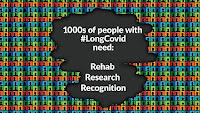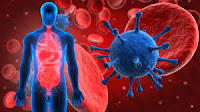There have been tens of thousands dying from this disease in the UK alone, but fortunately deaths have substantially reduced. That does not mean we can relax because:
- Deaths will accelerate again if we fail to continue with basic precautions
- LongCOVID is becoming an even bigger problem for survivors, affecting a large proportion of people of all ages, including children
- Lethargy, as can happen after any major infection
- Pain and other medical symptoms rising from damage to various organs around the body. This can happen to all ages, including children
- The mental health aspects, particularly depression. Here is a "LongHauler" discussing her experience, plus some tips
Update 8/9/20: The "excess deaths" so far this year are over 50,000. Professor Tim Spector is leading the COVID Symptom Study at King's College, London using the ZOE app, which is being used by over 4 million people. He has just reported on BBC Radio 4 higher numbers of people suffering from LongCOVID:
- Some 300,000 people have reported symptoms lasting for over a month
- Some 60,000 people have been ill for over three months
- Some people who were previously fit and healthy are confined to a wheelchair, whilst others find that a simple shopping trip or climbing stairs can leave them bed-ridden for days
LETHARGY
I know from personal experience that lethargy after a serious infection can last off and on for months, in my case a year. I was lucky to keep my job.
So no surprise that after having COVID-19, a significant proportion of people of all ages are complaining of lethargy like mine. That's whether they have been in hospital, just had mild symptoms at home, or even not displayed any usual COVID-19 symptoms.
Here's an
article describing extreme lethargy symptoms for younger adults, plus additional symptoms.
COVID-19 can be highly disruptive, to say the least. But the real problem is painful multi-organ damage, that you don't get with 'flu.
PAIN FROM ORGAN DAMAGE
The SARS-COV-2 virus that causes COVID-19 gets into human cells using the ACE2 receptor,
which is a feature of cells in some other organs including lungs, blood
vessels, heart, kidney, and intestines. Even the brain. Though
fortunately not skin.
If the virus gets into the bloodstream, such as having caused damage in the lungs, it can damage any organ by direct infection.
Once the virus is in the blood it can also cause microclotting, such that most people with COVID-19 in hospital need to be given blood thinners.
These microclots can themselves do damage to organs.
They can also cause strokes, even in healthy younger people "whether or not they are showing symptoms of the disease".
The microclots can also reduce the ability of the blood to accept oxygen from the lungs.
A quadruple whammy.
A quadruple whammy.
Those who caught COVID-19 back in March are still displaying symptoms now in August, five months later. How much longer we don't know. Often people who have not been hospitalised.
Here’s a discussion from the British Medical Journal published mid July.
This
article includes a quote from Paul Garner, a professor of infectious
diseases, who caught COVID-19 early on and was one of the first to bring
LongCOVID to the attention of the medical profession. He describes it
as “frightening and long.”. He reported a long list of symptoms lasting weeks and leaving him "feeling unable to function".
Another young doctor is reported to have returned to work after a fortnight off work with COVID-19, found "a month later her ill-health returned with a vengeance, leaving her incredibly fatigued and unable to perform even the simplest of tasks ever since."
LongCOVID can affect people of any age. In children it's called MIS-C, Multisystem Inflammatory Syndrome in Children, which is a similar multi-organ problem to that which affects adults. Here's a new paper published in The Lancet, which says:
"In the past 3 months, there have been increasing reports from Europe, North America, Asia, and Latin America describing children and adolescents with COVID-19-associated multisystem inflammatory conditions, which seem to develop after the infection rather than during the acute stage of COVID-19."
Here is a summary of persistent symptoms suffered by a group of Italians who had had COVID-19. Fatigue and breathlessness each affected around half of people. Joint pain and chest pain are each around 20%, unrelated to lungs . The least common symptom after two months is diarrhoea, at 3% more common than dying, Clearly LongCOVID is a big issue:
This study from Holland covered 1,622 COVID-19 sufferers of which 91% had not been to hospital. (If your translation of the title says "homeowners" it should be "home sitters", as in people being ill at home), "The average age is 53, by far the largest group (85 percent) say their health was good before the corona infection. Now that is only 6 percent. Almost half indicate that they can no longer exercise after corona, more than 6 in 10 even have problems with walking. "That is shocking," says Michael Rutgers. “60 percent of those surveyed had not previously been treated by a doctor. These are just healthy people who are now wondering if they will ever fully recover from corona." ”
For those who have been in hospital, this study suggests LongCOVID rises to 75% after three months. Many were struggling to carry out daily tasks such as washing, dressing or going back to work.
 |
| Hair falling out in clumps |
If that isn't enough to persuade you that you don't want to catch COVID-19, here are reports of hair loss, here and here due to a condition called "Telogen Effluvium"
So serious is the LongCOVID issue that the NHS is launching a rehabilitation service,
and are opening rehabilitation centres around the country, supported by
teams of physiotherapists, nurses and mental health specialists.
A major concern is that younger adults have seen that deaths have mainly affected older people, and so have felt they need not take precautions. LongCOVID can readily affect them too.
 Devi Sridhar, an advisor to the Scottish government and a member of the Independent SAGE group warns at 30min30 that this virus is “too
dangerous to spread through the population, not only because of the
mortality [dying] but because of the morbidity [LongCOVID] it causes in
young adults…that’s going to be the story about COVID, not about the
deaths”. Chilling stuff.
Devi Sridhar, an advisor to the Scottish government and a member of the Independent SAGE group warns at 30min30 that this virus is “too
dangerous to spread through the population, not only because of the
mortality [dying] but because of the morbidity [LongCOVID] it causes in
young adults…that’s going to be the story about COVID, not about the
deaths”. Chilling stuff.IF YOU ARE SUFFERING FROM LONGCOVID
Whatever your symptoms, always consult your GP.
 A new organisation called the "Long Covid Support Group" has been set up working in partnership with the UK Sepsis Trust. It is on social media:
A new organisation called the "Long Covid Support Group" has been set up working in partnership with the UK Sepsis Trust. It is on social media: - Facebook, as a private group you can join
IN CONCLUSION
If you have had COVID-19 and have not experienced any LongCOVID symptoms, consider yourself lucky. It does not affect everyone.
But given that LongCOVID affects far more people than die, it is impact of COVID-19 on the survivors that is becoming important. Research is underway, with initial indications being that some aspect of LongCOVID can affect over half of individuals, as above.
That and the other risks of COVID-19.
Which means we must take COVID-19 seriously, even with deaths diminishing. We must minimise the number of infections. Preferably below 2 per day per hundred thousand people in a community., as Professor Chris Whitty has indicated.











No comments:
Post a Comment